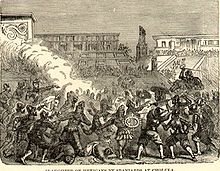- Cholula (Mesoamerican site)
-
This article is about the pre-Columbian polity and archaeological site. For the present-day Mexican city, see Cholula, Puebla. For other uses, see Cholula (disambiguation).
Cholula (Nahuatl: Cholōllān), was an important city of pre-Columbian Mesoamerica, dating back to at least the 2nd century BCE, with settlement as a village going back at least some thousand years earlier. The great site of Cholula stands just west of the modern city of Puebla. Its immense pyramid exceeds the Pyramid of the Sun at Teotihuacan in volume. It is the largest pyramid structure in the Americas.
Contents
History
Cholula grew from a small village to a regional center between 600 and 700 CE. During this period, Cholula was a major center contemporaneous with Teotihuacan and seems to have avoided, at least partially, that city's fate of violent destruction at the end of the Mesoamerican Classic period.
Between 700 and 750 CE, Cholula was taken over by the Olmeca-Xicalanca, and the town grew rapidly,[1] although overshadowed by Cacaxtla. The Olmeca-Xicalanca were in 1292 in turn displaced by the Tolteca-Chichimeca. In 1359, the nearby kingdom of Huexotzingo annexed Cholula.[2]
During this entire period, Cholula remained a regional center of importance, enough so that, at the time of the fall of the Aztec empire, Aztec princes were still formally anointed by a Cholulan priest.
At the time of the arrival of Hernán Cortés Cholula was second only to the Aztec capital Tenochtitlan (modern Mexico City) as the largest city in central Mexico, possibly with a population of up to 100,000 people. In addition to the great temple of Quetzalcoatl and various palaces, the city had 365 temples.[citation needed]
In 1519 Cortés, either in a pre-meditated effort to instil fear upon the Aztecs waiting for him at Tenochtitlan or, as he later claimed when under investigation, wished to make an example of the natives who had planned to massacre him and his soldiers when they left the city. The native treachery was exposed by two priests who under questioning revealed the plot. When the warriors and nobles gathered, Cortez had them massacred at the central plaza and partially burned down the city.[3]
A few years later Cortés vowed that the city would be rebuilt with a Christian church to replace each of the old pagan temples; less than 50 new churches were actually built, but the Spanish colonial churches are unusually numerous for a city of its size. There is a common saying in Cholula that there is a church for every day of the year.
Cholula was significant during the Spanish Colonial period because it remained one of the nearby provinces that remained unconquered by the Aztecs. They were instrumental in helping the Spanish to conquer the Aztecs.
During the Spanish Colonial period Cholula was overtaken in importance by the nearby city of Puebla.
Great Pyramid of Cholula
Main article: Great Pyramid of CholulaCholula is most famous as the site of the Great Pyramid of Cholula, the largest man-made monument by volume in the world. Note that the Great Wall of China was designed as a fortification and not as a monument.[citation needed]
Notes
- ^ Pohl. Davies, p. 93. Other scattered sources this happened 50 to 100 years earlier.
- ^ Coe, p. 107.
- ^ http://www.historians.org/tl/lessonplans/ca/fitch/cholula.html
References
- Coe, M.D. (2002); Mexico: From the Olmecs to the Aztecs London: Thames and Hudson.
- Davies, Nigel (1982) The Ancient Kingdoms of Mexico, Penguin Books.
- Pohl, John; "Major Archaeological Sites: Cholula", in John Pohl's Mesoamerica, Foundation for the Advancement of Mesoamerican Studies, Inc., access March 2007.
External links
- The pyramid of Cholula, Puebla State government (Spanish)
- Cholula photos, Tour By Mexico
- Cholula, Foundation for the Advancement of Mesoamerican Studies
Categories:- Mesoamerican sites
- Former populated places in Mexico
- Archaeological sites in Puebla
Wikimedia Foundation. 2010.





